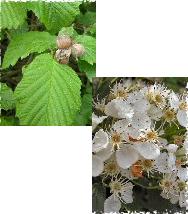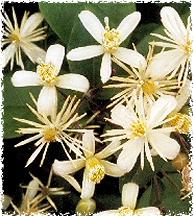


|
Trees and Hedge Plants
Mixed hedgerows are important wildlife habitats, providing food, nesting
sites and shelter for birds, small mammals and insects. A hedgerow also
provides safe corridors for small mammals to travel from one area to another,
and songposts and viewpoints for birds to perch on. Once your hedge is
established (after 3 years or so), you can further increase its wildlife
value by planting climbers such as Honeysuckle and Wild Clematis to wind
their way amongst the hedge plants. Honeysuckle is popular with moths,
butterflies, bees and birds - thrushes, robins, tits and blackbirds will
feast on the berries and seeds, and another bird in particular, the Pied
Flycatcher, uses Honeysuckle bark as part of its nesting material. Wild
Clematis provides food and nesting material for birds, moths and bees.
The information contained in the links below show just how many species
of butterfly, moth, bird, mammal and other insects our native trees support.
Some are veritable micro-cities for wildlife. Hedgerows in the coutryside
have declined dramatically over the years, their decline in turn affecting
the numbers of wildlife. By planting even one native tree you will be
helping wildlife in some way.
Planting a Wildlife Hedge
You can plant your hedge as a single row of plants, about 30 cm or so
apart, or as a staggered double hedge with 30 cms or so between rows.
As a rough guide (and guidelines vary from hedge supplier to hedge supplier!)
plan for 4 plants per metre length - although you could vary this depending
on how dense you want the hedge. If you are not able to plant as soon
as you receive the hedging, then heel in the plants by digging a small,
narrow trench and laying them in at a 45 degree angle. If they only have
to sit a day or so you could keep them in a bucket of water. To suppress
weeds and aid water conservation for the plants, mulch the base of your
hedge. Once planted, trim off half the height of the hedge and then for
the first two or three years remove at least half of the new growth. Once
your hedge is established, trim it every third year - but never trim during
nesting season (1 March to 1 September). In fact, it is an offence under
the Wildlife and Countryside Act 1981 to intentionally destroy a nest
that is used or being used. It is more ideal to trim in February to allow
the nuts and berries to be available for a longer period to birds and
mammals.
Maintenance of Your Wildlife Hedge
Trim well for the first two or three years to encourage bushiness. As
mentioned above, once established, the hedge can be kept trimmed every
two or three years. The best shape for a hedge is A shaped as this allows
light and rain to reach the bottom of the hedge. Once your hedge is growing
well, you can then introduce wild climbers. Planting them before the hedge
is well established will result in the hedge plants being overwhelmed
and strangled. It is also a good idea to plant hedegrow wildflowers at
the base to provide extra cover for birds and mammals and additional food
sources for other wildlife. Include here such plants as White Campion,
Hedge Bedstraw, Greater Stitchwort, Wild Primrose, Black Horehound, Agrimony,
Red Campion, Wild Basil, Wild Srawberry and Nettle-leaved Bellflower
(these and other hedgerow plants are all available from us!)
What Trees to Plant
First of all, you need to consider what sort of hedge you are aiming for
- is it going to be a wildlife hedge, a security hedge or barrier, for example.
If you are planning to plant a wildlife hedge you need to bear in mind that
this will not be regularly pruned and so will grow tall, and so you need
to ensure you haev the space for it - a single row hedge could grow to be
as much as 5 ft wide when fully mature after a number of years; a double
row hedge even wider! If you want a hedge primarily as a barrier against
intruders you might want to consider predominantly thorny plants. If, on
the other hand, your hedge is just serving as a boundary or divider then
you an quite happily trim it every year - but at the expense of fruits and
berries for wildlife. The most wildlife-friendly hedge includes Hawthorn
as the bulk of its make-up. Again, opinion varies as to how much Hawthorn
to include, ranging from 25% to 75%. However much hawthorn you decide to
incorporate, plant up the rest of the hedge with around four other species
in varying amounts. It is a good idea to look at other native hedges in
your surrounding area to see what plants they consist of and then plant
the same in your hedge so that you are keeping your plants native to your
local area.
|
 01227 730242
01227 730242
 Payments made online are processed via WorldPay, using 128 bit encryption and secure server
Payments made online are processed via WorldPay, using 128 bit encryption and secure server



